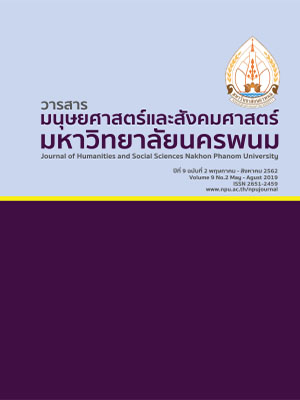A Model of Spatial Data Management: Case Study of Ban Nongkha Community, Pracha Phatthana Sub-District, Wapi Pathum District; Maha Sarakham Province
Main Article Content
Abstract
The Research Purposes were 1) to study needs to develop a model of Spatial Data Management according to the new theory of Sufficiency Economy Philosophy for a case Study of Ban Nongkha Community, Pracha Phatthana Sub-District, Wapi Pathum District; Maha Sarakham Province. 2) to develop a model of Spatial Data Management according to the new theory of Sufficiency Economy Philosophy. 3) to evaluate a model of Spatial Data Management according to the new theory of Sufficiency Economy Philosophy, divided to 3 steps : Step1 to study needs to develop a model of Spatial Data Management according to the new theory of Sufficiency Economy Philosophy. According to PAOR Process (Kemmis & Taggart) step (1) Planning: samples (20 persons) classified as (1) Community Leader (10) (2) Experts from IT Faculty (10) step (2) Action: samples (80 persons) classified as (1) Community Leader (10) (2) Community members (40) (3) Experts from IT Faculty (10) (4) students (40) step (3) Observation: samples (80 persons) classified as step(2) and step (4) Reflection: samples (40 persons) classified as (1) Community Leader (10) (2) Community members (10) (3) Experts from IT Faculty (10) (4) Authorities for Academic Services (10). Step2 to develop a model of Spatial Data Management according to the new theory of Sufficiency Economy Philosophy, area used for 800 square meters. Step3 to evaluate a model of Spatial Data Management according to the new theory of Sufficiency Economy Philosophy being 7 experts from Faculty of IT, Faculty of Agriculture Technology and Faculty of Education. The research instruments being (1) form of unstructured interview, (2) a handbook of Spatial Data Management as a model of opened and closed system and (3) evaluation forms of a model of Spatial Data Management according to the new theory of Sufficiency Economy Philosophy. The research statistics used as Mean ( ), Standard Deviation (S.D.)
The Research findings were: 1) The needs to develop a model of Spatial comprised of 4 steps: (1) planning: have to be relevant to community needs. (2) action: knowledge sharing among activity participants. (3) observation: having activities among community leaders and activity participants. And (4) reflection: having to reflect as a real problems, problem-solving, reflecting a new problem and the needs of plantation system management in Sufficiency Economy area. 2)The development of a model of Spatial Data Management according to the new theory of Sufficiency Economy Philosophy comprised of 2 models being (1) a model of opened system (Internet of Things) (IoT) (2) a model of closed system (Automatic System). 3) The evaluation results of a model of Spatial Data Management according to the new theory of Sufficiency Economy Philosophy by overall being at the most. ( = 4.58, S.D. = 0.50).
Article Details
References
โกวิทย์ กังสนันท์. (2556 กันยายน 2555- กุมภาพันธ์2556). “ตัวแบบการพัฒนาชุมชนที่ยั่งยืน”, วารสารการเมือง การปกครองมหาวิทยาลัยมหาสารคาม. 3 (1) ; 1-17.
ข้อมูลชุมชนบ้านหนองข่า. (2558). การจัดทำแผนชุมชน. มหาสารคาม : ที่ทำการผู้ใหญ่บ้านหนองข่าหมู่ที่ 8.
ชนะชัย อวนวัง. (2558). รายงานโครงการบริการวิชาการ “โครงการตะลุยค่ายเทคโนโลยีสารสนเทศภูมิศาสตร์ตามปรัชญาเศรษฐกิจพอเพียง”.มหาสารคาม : คณะเทคโนโลยีสารสนเทศและสำนักบริการวิชาการ มหาวิทยาลัยราชภัฏมหาสารคาม.
ชุลีกร สายเกียรติวัติ และพิชญาภา ยวงสร้อย. (2560, มกราคม – มีนาคม). “การพัฒนารูปแบบการจัดการเรียนรู้ตามหลักปรัชญาของเศรษฐกิจพอเพียงเพื่อส่งเสริมมโนทัศน์ในการดำเนินชีวิตอย่างพอเพียงในวิถีอาเซียนสำหรับนักเรียนชั้นประถมศึกษา”, วารสารศึกษาศาสตร์ มหาวิทยาลัยนเรศวร. 19 (1) ; 219-230.
บุญชม ศรีสะอาด. (2558). การวิจัยเบื้องต้น. พิมพ์ครั้งที่ 9. กรุงเทพฯ : สุวีริยาสาส์น.
พรรณวิภา อรุณจิตต์ นาวี โกรธกล้า และ ปิจิราวุช เวียงจันดา. (2558). “โรงเรือนปลูกพืชควบคุมและมอนิเตอร์อัตโนมัติผ่านระบบเครือข่าย” การประชุมวิชาการสมาคมวิศวกรรมเกษตรแห่งประเทศไทยระดับชาติ ครั้งที่ 16 ประจำปี 2556 และระดับนานาชาติ ครั้งที่ 8 ; 454-458.
มูลนิธิชัยพัฒนา. (2560). เศรษฐกิจพอเพียง. สืบค้นเมื่อวันที่ 28 กันยายน 2560,จาก
http://www.chaipat.or.th/publication/publish-document/sufficiency-economy.html
สุธรรม ธรรมทัศนานนท์. (2560 มกราคม-เมษายน). “การพัฒนารูปแบบการบริหารจัดการตามหลักปรัชญาเศรษฐกิจพอเพียงสำหรับสถานศึกษาสังกัดสำนักงานเขตพื้นที่การศึกษามัธยมศึกษา เขต 27”, วารสารศึกษาศาสตร์มหาวิทยาลัยมหาสารคาม. 28 (1) : 140-153.
สุวัฒนพงษ์ ร่มศรี เพิ่มพูล ร่มศรีและสัญญา เคณาภูมิ. (2559). “การพัฒนารูปแบบการนำผลการประเมินคุณภาพการศึกษาสำนักงานเขตพื้นที่การศึกษาร้อยเอ็ดเขต 1”, วารสารวิทยาลัยนครราชสีมา 10 (2) ; 323-335.
สำนักงานพัฒนาเทคโนโลยีอวกาศและภูมิสารสนเทศ (องค์การมหาชน). (2552). ตำราเทคโนโลยีอวกาศและภูมิสารสนเทศศาสตร์. กรุงเทพฯ : อมรินทร์พริ้นติ้งแอนด์พับลิชชิง จำกัด (มหาชน).
Kemmis, S & Mc. Taggart, R. (1990). The Action Research Planner. 3rd ed.Victoria : Deakin University Press
Translated Thai References
Arunjit, P. Grohtgla N. & Viengjinda P. (2015). “Controlled Plant House and Automatic Monitoring to Network System”, The 16th TSAE National and The 8 th TSAE International Conference ; 454-458. [in Thai]
Ban Nongkha Community Data. (2015). Ban Nongkha Community Community Data Planning. Maha SaraKham : Nongha 8 Office of the Village Headman [in Thai]
Geo-Informatics and Space Technology Development Agency (Public Organization). (2009). A Textbook of Space Technology and Geo-Informatics, Amarin Printing & Publishing Public Co., Ltd., Bangkok Thailand. [in Thai]
Kungsanant, K. (2013 September 2012-February2013). “A Model for Sustainable Community Development –SCD”, Journal of Politics and Governance Maha Sarakham University. 3(1) ; 1-17. [in Thai]
Kemmis, S & Mc. Taggart, R. (1990). The Action Research Planner. 3rd ed.Victoria : Deakin University Press
Ministry of Foreign Aftairs. (2015). Precision Agriculture in European Union [Online]. [Accessed December
30, 2015]. Available from: URL: http://www2.thaieurope.net. [in Thai]
Romsri, S. Romsri, P. & Kenaphoom, S. (2016 July-December). “Model Development for Using the Educational Quality Assessment Results, Office of Rio-et Primary Education Area1”, Journal of Nakhonratchasima College. 10 (2) ; 323-335. [in Thai]
Saikietiwat, C. Yuangsoi. (2017 January–March). “Learning Management Philosophy Model Based on the Sufficiency Economy Philosophy to Enhance the Concept of Living Adequate in The Asean way for Elementary Students”, Journal of Education Naresuan University. 19 (1) ; 219-230. [in Thai]
Seesa-ard, B. (2015). Basic Research. Suweeriyasarn, 9th ed, Bangkok, Thailand. [in Thai]
The Chaipattana Foundation. (2017). Sufficiency Economy Philosophy [Online]. [Accessed September
28, 2017]. Available from : URL: http://www.Chaipat.or.th/Publication/Publish-Document/Sufficiency-Economy.html. [in Thai]
Thummatassananon, S. (2517 January-April). “The Developing of Model for School Management According to Sufficiency Economy Philosophy for Secondary Schools under the Jurisdiction of District 27”, Journal of Education MahaSalaKham University. 28 (1) : 140-153 [in Thai]
Uanwang, C. (2015). Report of Academic Service Project “Tacking Action Geo-informatics Camp According to Sufficiency Economy Philosophy”, Maha Sarakham : Faculty of Information Technology and Academic Service Rajabhat Maha Sarakham University. [in Thai]


